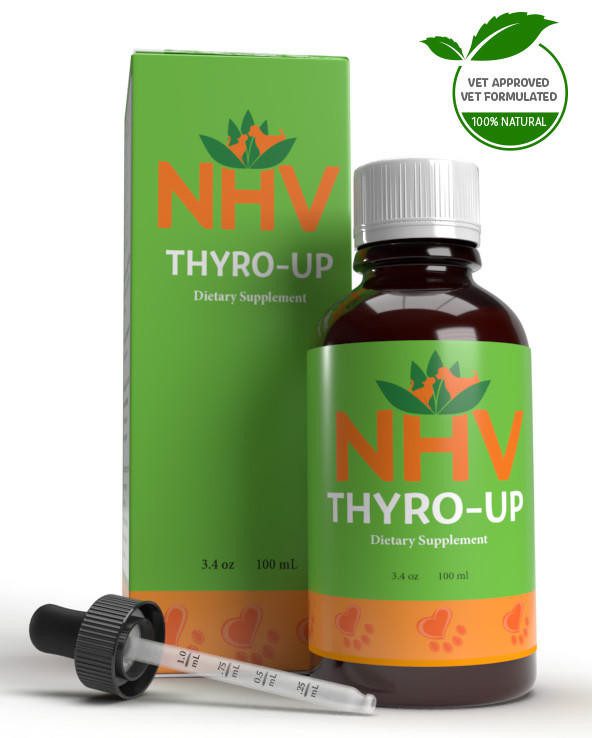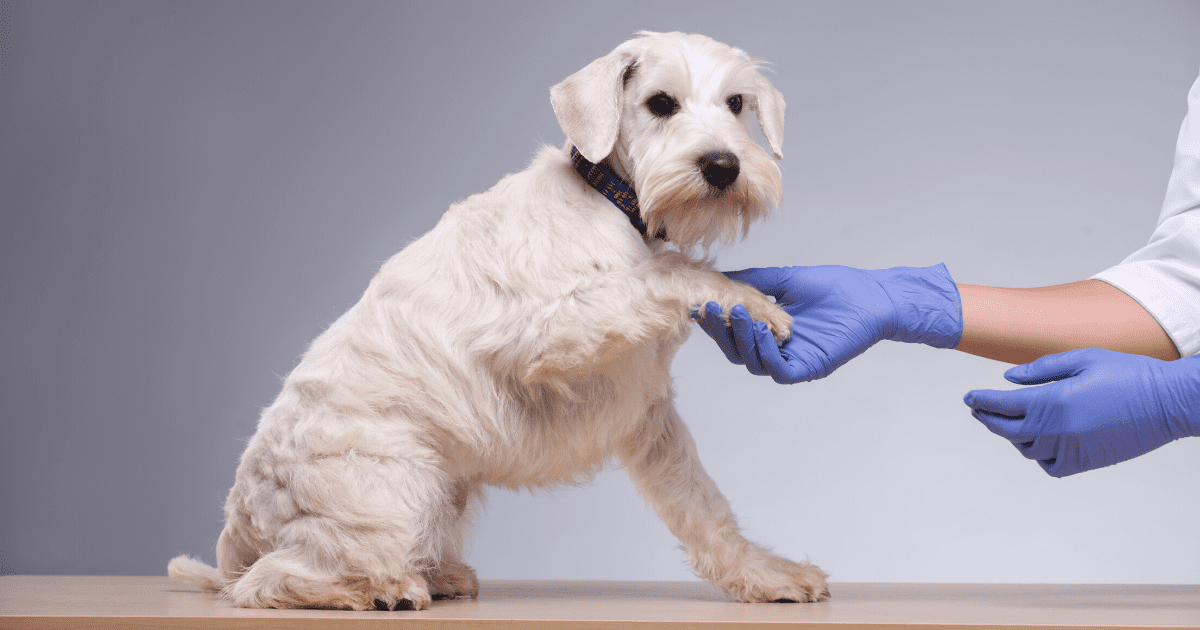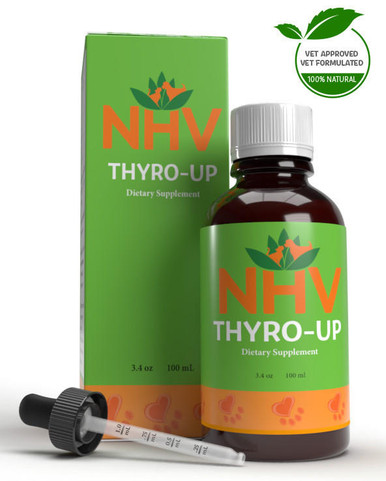hypothyroidism support

free shipping over $100 (USA & Canada)
1-877-937-4372 the pet expert hotline

Hypothyroidism in dogs refers to an underactive thyroid gland in your pet. This means that the gland, located in the neck near the trachea, has compromised functions and it is not producing enough thyroid hormone resulting in a decrease in the metabolic rate.
One of two diseases can cause hypothyroidism in dogs:
Other causes like rare diseases and cancer can also be related to hypothyroidism, but occur in very few cases.
This condition causes the metabolic rate to slow down, affecting a majority of the organs in the body. Most dogs develop symptoms like:
Other dogs will develop even more severe symptoms like:

Hypothyroidism can be diagnosed with a blood exam called Total Thyroxine (TT4), which measures the blood level of one of the thyroid hormones. Some veterinarians can conduct this in-house, while others may need to send it to an external lab for testing. More often than not, based on the blood results and clinical signs, a diagnosis is reached. If necessary, the veterinarian can request extra exams like the Free T4 by equilibrium dialysis (FT4 by ED) and/or a T3 Suppression test. If a definitive diagnosis is not reached with the aforementioned blood tests, a thyroid scan (thyroid scintigraphy) may also be performed, or a recheck of the TT4 after a few weeks may be conducted.
Your local vet is best equipped to treat your dog based on the clinical signs and the diagnostic results. Hypothyroidism is treatable, but there is no cure, and usually requires a lifelong prescribed, oral medication. The best way to take care of a dog with hypothyroidism is by talking to your vet and following their treatment plan so as to keep your dog comfortable, healthy, and have the condition under control.
Also, at NHV, our pet experts and in-house veterinarians can help you with questions and guidance on how to take care of them naturally.

All of our herbal supplements are vet-formulated and are safe for long-term use. They can be used on their own or alongside medications. Below are some supplements that are a good addition for pets with hypothyroidism:
Thyro-Up is formulated specifically to help the thyroid gland by aiding in balancing the thyroid hormones and functions.
Multi Essentials help to replenish vital nutrients and help provide a boost in energy some hypothyroid dogs need. As hypothyroidism can result in a nutrient void, due to a decreased metabolic rate, this supplement may aid by providing a furbaby with vital minerals and vitamins.
A balanced, vet-formulated diet is also key in keeping a furbaby with hypothyroidism healthy and happy. These diets are specific for a little one with hypothyroidism and their unique nutritional requirements. A vet-formulated Nutrition Plan can be great additional support alongside the vet treatment plan and the NHV supplements.
hypothyroidism support

Support for Dogs with Hypothyroidism
buy 2 and save $3
3 month supply for a small to medium size
Support your pet’s hypothyroidism with Thyro-Up, an all-natural dog thyroid supplement that helps boost energy and may help promote normal hormone levels within the thyroid gland.

Support your pet’s hypothyroidism with Thyro-Up, an all-natural dog thyroid supplement that helps boost energy and may help promote normal hormone levels within the thyroid gland.
Powerful Thyroid Support for Your Dog
Hypothyroidism can be a real bummer for dogs. It’s a condition that primarily affects older dogs, and comes with symptoms like weight gain, loss of appetite, sluggishness, and hair loss. In addition to the medication prescribed by your pet’s vet, a natural thyroid supplement for your dog can help give them comprehensive support. Thyro-Up is used to support hypothyroidism in dogs.
How Thyro-Up Can Help Your Dog with Hypothyroidism
NHV supplements are formulated with ingredients that are powerful, yet easy on your pet’s body. Thyro-Up is a thyroid supplement for dogs made with ingredients like Gotu Kola, Kelp, Astragalus, and Eleuthero. These plant-based extracts help balance hormones, stimulate an underactive thyroid gland, empower the immune system, and keep a healthy metabolism.
Thyro-Up is safe to take with conventional medicines, and safe to take long-term. Use it together with treatment prescribed by your dog’s veterinarian for comprehensive and effective support.
Use Thyro-Up for Comprehensive Support
Help support your dog’s thyroid function and maintain natural thyroid hormone production with Thyro-Up, an all-natural dog thyroid supplement developed by veterinarians with 20+ years of experience. Have questions? Contact us on the pet expert hotline at 1-877-9374372.

Eleuthero – Helps balance the thyroid and maintain a healthy metabolism.
Kelp – This iodine-rich ingredient stimulates the underactive thyroid gland.
Astragalus – A sweet tonic herb that helps support the thyroid gland and maintains the immune and circulatory systems.
Gotu Kola – A mild diuretic that helps balance hormones. High in antioxidants and beneficial to the skin and coat.
Ginkgo – A kidney tonic that helps maintain body temperature. Supports the cardiovascular and nervous systems.
Licorice – A natural anti-inflammatory with immune-supporting properties.
Watercress – A vitamin and mineral-rich plant that supports digestion.
Papaya – Helps aid digestion and the absorption of nutrients from food.
Cayenne – Helps support the circulatory and digestive systems.
Select your pet's weight to determine the correct dose.
To be taken twice daily. Determine your pet’s weight and then use the easy chart below to determine the correct dose. This is the minimum dosage.
Pet's Weight Dosage
0 - 15 lb = 0.5 ml
16 - 30 lb = 1.0 ml
31 - 45 lb = 1.5 ml
46 - 60 lb = 2.0 ml
61 - 75 lb = 2.5 ml
Over 75 lb = 3.0 ml
How to Administer
Shake well before use. The easiest method is to use the dropper provide and places the drops into your pet’s food or favorite treat. You can also use the dropper and squirt directly into the pet’s mouth.
Some pets can be finicky, if this occurs consider hiding the drops in foods most pet’s love such as fish, chicken or yogurt or a favorite treat. If your pet only eats dry food then soak a few kibbles at feeding time.
For Best Results
Herbal dietary supplements are beneficial to the health and wellbeing of your pet and are safe for long-term use. Every pet responds to natural herbal supplements differently, therefore it is important to be consistent and administer the product daily. Supplements generally take two to four weeks to take effect, however this will vary from one animal to the next.
Product Storage
All NHV Natural Pet Products are pure herbal extracts and contain no artificial additives, preservatives or coloring. Shelf life after opening is 6 months and must be refrigerated after opening.
Cautions and Contraindications
Do not use Thyro-Up in pregnant or nursing animals.
Do not use if your pet has hyperthyroidism (over active thyroid gland). Speak to your vet before using our products. A second visit is recommended if your pet’s condition does not improve, or deteriorates after continued use of the supplements.
All information provided by NHV Natural Pet Products is for educational purposes only.
Powerful Thyroid Support for Your Dog
Hypothyroidism can be a real bummer for dogs. It’s a condition that primarily affects older dogs, and comes with symptoms like weight gain, loss of appetite, sluggishness, and hair loss. In addition to the medication prescribed by your pet’s vet, a natural thyroid supplement for your dog can help give them comprehensive support. Thyro-Up is used to support hypothyroidism in dogs.
How Thyro-Up Can Help Your Dog with Hypothyroidism
NHV supplements are formulated with ingredients that are powerful, yet easy on your pet’s body. Thyro-Up is a thyroid supplement for dogs made with ingredients like Gotu Kola, Kelp, Astragalus, and Eleuthero. These plant-based extracts help balance hormones, stimulate an underactive thyroid gland, empower the immune system, and keep a healthy metabolism.
Thyro-Up is safe to take with conventional medicines, and safe to take long-term. Use it together with treatment prescribed by your dog’s veterinarian for comprehensive and effective support.
Use Thyro-Up for Comprehensive Support
Help support your dog’s thyroid function and maintain natural thyroid hormone production with Thyro-Up, an all-natural dog thyroid supplement developed by veterinarians with 20+ years of experience. Have questions? Contact us on the pet expert hotline at 1-877-9374372.

Eleuthero – Helps balance the thyroid and maintain a healthy metabolism.
Kelp – This iodine-rich ingredient stimulates the underactive thyroid gland.
Astragalus – A sweet tonic herb that helps support the thyroid gland and maintains the immune and circulatory systems.
Gotu Kola – A mild diuretic that helps balance hormones. High in antioxidants and beneficial to the skin and coat.
Ginkgo – A kidney tonic that helps maintain body temperature. Supports the cardiovascular and nervous systems.
Licorice – A natural anti-inflammatory with immune-supporting properties.
Watercress – A vitamin and mineral-rich plant that supports digestion.
Papaya – Helps aid digestion and the absorption of nutrients from food.
Cayenne – Helps support the circulatory and digestive systems.
Select your pet's weight to determine the correct dose.
To be taken twice daily. Determine your pet’s weight and then use the easy chart below to determine the correct dose. This is the minimum dosage.
Pet's Weight Dosage
0 - 15 lb = 0.5 ml
16 - 30 lb = 1.0 ml
31 - 45 lb = 1.5 ml
46 - 60 lb = 2.0 ml
61 - 75 lb = 2.5 ml
Over 75 lb = 3.0 ml
How to Administer
Shake well before use. The easiest method is to use the dropper provide and places the drops into your pet’s food or favorite treat. You can also use the dropper and squirt directly into the pet’s mouth.
Some pets can be finicky, if this occurs consider hiding the drops in foods most pet’s love such as fish, chicken or yogurt or a favorite treat. If your pet only eats dry food then soak a few kibbles at feeding time.
For Best Results
Herbal dietary supplements are beneficial to the health and wellbeing of your pet and are safe for long-term use. Every pet responds to natural herbal supplements differently, therefore it is important to be consistent and administer the product daily. Supplements generally take two to four weeks to take effect, however this will vary from one animal to the next.
Product Storage
All NHV Natural Pet Products are pure herbal extracts and contain no artificial additives, preservatives or coloring. Shelf life after opening is 6 months and must be refrigerated after opening.
Cautions and Contraindications
Do not use Thyro-Up in pregnant or nursing animals.
Do not use if your pet has hyperthyroidism (over active thyroid gland). Speak to your vet before using our products. A second visit is recommended if your pet’s condition does not improve, or deteriorates after continued use of the supplements.
All information provided by NHV Natural Pet Products is for educational purposes only.
hypothyroidism support

Thyro-Up & Multi Essentials
bundle and save with pet expert kits
3 month supply for a small to medium size pet
Hypothyroidism is a slow-developing condition and may be misdiagnosed as normal signs of aging. For natural support, our Hypothyroidism Kit is beneficial for dogs and cats with lowered thyroid function who need added nutritional support.


Hypothyroidism is a slow-developing condition and may be misdiagnosed as normal signs of aging. For natural support, our Hypothyroidism Kit is beneficial for dogs and cats with lowered thyroid function who need added nutritional support.

Hypothyroidism (underactive thyroid) is a condition that affects many pets, including dogs and cats. Apart from slowing down, if you notice that your little one’s fur is thinning, their skin is dry and dull or they have sudden weight gain, you may want to book a visit with your vet to run some tests, including a TT4 test, which is a measurement of thyroid hormone levels in the blood.
For pets suffering with hypothyroidism, we'd suggest adding natural pet thyroid supplements like our Thyro-Up and Multi Essentials to support their glandular system as well as support their metabolism.
Hypothyroidism can cause a lot of discomfort for your pet. If left untreated, hypothyroidism may lead to secondary health issues like cardiovascular disease. Ingredients like eleuthero and ginkgo support healthy thyroid function, and brain function. Kelp is rich in iodine which helps activate the thyroid gland while ingredients like licorice and gotu kola contain many beneficial properties for stimulating thyroid hormone production. The antioxidant and sedative properties in Thyro Up help to protect the body from cell damage, and help to soothe inflammation and discomfort. Multi Essentials contains a range of vitamins, minerals and trace elements that are formulated to help stimulate metabolism, promote healthy skin/coat, improve digestion, energy levels and help to fill nutritional voids.
Part of being a pet parent is keeping your furry friend healthy and comfortable. When it comes to natural cat thyroid supplements, our blends have been developed by a holistic veterinarian and a master herbalist to formulate a gentle yet effective remedy to support glandular health. For any questions or concerns about your furkiddo’s thyroid function or overall vitality, an NHV Pet Expert is there to help you every step of the way.
Made with the finest, organically grown, or ethically harvested herbs. Made specifically for pets, vet-formulated, and vet approved.
Thyro-Up for Dogs and Cats
Multi Essentials
Select your pet's weight to determine the correct dose.
To be taken twice daily. Determine your pet’s weight and then use the easy chart below to determine the correct dose. This is the minimum dosage.
Pet's Weight Dosage
0 - 15 lb = 0.5 ml
16 - 30 lb = 1.0 ml
31 - 45 lb = 1.5 ml
46 - 60 lb = 2.0 ml
61 - 75 lb = 2.5 ml
Over 75 lb = 3.0 ml
How to Administer
Shake well before use. The easiest method is to use the dropper provided and place the drops into your pet’s food or favorite treat. You can also use the dropper and squirt directly into the pet’s mouth. Some pets can be finicky, if this occurs consider hiding the drops in foods most pet’s love such as fish, chicken or yogurt or a favorite treat. If your pet only eats dry food then soak a few kibbles at feeding time.
For Best Results
Herbal dietary supplements are beneficial to the health and well-being of your pet and are safe for long-term use. Every pet responds to natural herbal supplements differently, therefore it is important to be consistent and administer the product daily. Supplements generally take two to four weeks to take effect, however this will vary from one animal to the next.
Product Storage
All NHV Natural Pet Products are pure herbal extracts and contain no artificial additives, preservatives or coloring. Shelf life after opening is 6 months and must be refrigerated after opening.
Cautions and Contraindications
Do not use in pregnant or nursing animals.
All information provided by NHV Natural Pet Products is for educational purposes only.
Hypothyroidism (underactive thyroid) is a condition that affects many pets, including dogs and cats. Apart from slowing down, if you notice that your little one’s fur is thinning, their skin is dry and dull or they have sudden weight gain, you may want to book a visit with your vet to run some tests, including a TT4 test, which is a measurement of thyroid hormone levels in the blood.
For pets suffering with hypothyroidism, we'd suggest adding natural pet thyroid supplements like our Thyro-Up and Multi Essentials to support their glandular system as well as support their metabolism.
Hypothyroidism can cause a lot of discomfort for your pet. If left untreated, hypothyroidism may lead to secondary health issues like cardiovascular disease. Ingredients like eleuthero and ginkgo support healthy thyroid function, and brain function. Kelp is rich in iodine which helps activate the thyroid gland while ingredients like licorice and gotu kola contain many beneficial properties for stimulating thyroid hormone production. The antioxidant and sedative properties in Thyro Up help to protect the body from cell damage, and help to soothe inflammation and discomfort. Multi Essentials contains a range of vitamins, minerals and trace elements that are formulated to help stimulate metabolism, promote healthy skin/coat, improve digestion, energy levels and help to fill nutritional voids.
Part of being a pet parent is keeping your furry friend healthy and comfortable. When it comes to natural cat thyroid supplements, our blends have been developed by a holistic veterinarian and a master herbalist to formulate a gentle yet effective remedy to support glandular health. For any questions or concerns about your furkiddo’s thyroid function or overall vitality, an NHV Pet Expert is there to help you every step of the way.
Made with the finest, organically grown, or ethically harvested herbs. Made specifically for pets, vet-formulated, and vet approved.
Thyro-Up for Dogs and Cats
Multi Essentials
Select your pet's weight to determine the correct dose.
To be taken twice daily. Determine your pet’s weight and then use the easy chart below to determine the correct dose. This is the minimum dosage.
Pet's Weight Dosage
0 - 15 lb = 0.5 ml
16 - 30 lb = 1.0 ml
31 - 45 lb = 1.5 ml
46 - 60 lb = 2.0 ml
61 - 75 lb = 2.5 ml
Over 75 lb = 3.0 ml
How to Administer
Shake well before use. The easiest method is to use the dropper provided and place the drops into your pet’s food or favorite treat. You can also use the dropper and squirt directly into the pet’s mouth. Some pets can be finicky, if this occurs consider hiding the drops in foods most pet’s love such as fish, chicken or yogurt or a favorite treat. If your pet only eats dry food then soak a few kibbles at feeding time.
For Best Results
Herbal dietary supplements are beneficial to the health and well-being of your pet and are safe for long-term use. Every pet responds to natural herbal supplements differently, therefore it is important to be consistent and administer the product daily. Supplements generally take two to four weeks to take effect, however this will vary from one animal to the next.
Product Storage
All NHV Natural Pet Products are pure herbal extracts and contain no artificial additives, preservatives or coloring. Shelf life after opening is 6 months and must be refrigerated after opening.
Cautions and Contraindications
Do not use in pregnant or nursing animals.
All information provided by NHV Natural Pet Products is for educational purposes only.
multivitamin support

Herbal Digestive Aid, Energy Booster, and Multivitamin for Dogs
buy 2 and save $3
3 month supply for a small to medium size pet
NHV’s multivitamins for dogs targets the brain, stomach, major arteries, kidneys, and liver with a powerful blend of herbal support.


NHV’s multivitamins for dogs targets the brain, stomach, major arteries, kidneys, and liver with a powerful blend of herbal support.

Millions of people take multivitamins daily to support their health, and it only makes sense our canine companions can benefit just as much. This 100% natural plant-based liquid blend can help your dog with nutritional deficiencies.
Signs of Possible Vitamin Deficiency in Dogs
NHV’s Multi-Essentials are packed with herbs that are rich in vitamins and minerals. This vet-formulated blend is designed to benefit your dog’s health using all-natural organically grown herbs with no additives or preservatives.
Even if your pet is healthy, supplying a multivitamin is essential to maintain good health, and some pets need more vitamins and minerals than others. For more, read NHV’s blog, vet talk with Dr. Hillary Cook.
Benefits of NHV’s Multivitamins for Dogs
You can read NHV's blog about the importance of dog vitamin supplements. All pets can benefit from NHV’s Natural Pet Product, even small exotic pets.
If you have questions about plant-based supplements including our multivitamins for dogs, you can schedule a consultation with one of our highly trained holistic veterinarians, because, at NHV, total health and wellness for all pets is our top priority.

Select your pet's weight to determine the correct dose.
To be taken twice daily. Determine your pet’s weight and then use the easy chart below to determine the correct dose. This is the minimum dosage.
Pet's Weight Dosage
0 - 15 lb = 0.5 ml
16 - 30 lb = 1.0 ml
31 - 45 lb = 1.5 ml
46 - 60 lb = 2.0 ml
61 - 75 lb = 2.5 ml
Over 75 lb = 3.0 ml
How to Administer
Shake well before use. The easiest method is to use the dropper provide and places the drops into your pet’s food or favorite treat. You can also use the dropper and squirt directly into the pet’s mouth.
Some pets can be finicky, if this occurs consider hiding the drops in foods most pet’s love such as fish, chicken or yogurt or a favourite treat. If your pet only eats dry food then soak a few kibbles at feeding time.
For Best Results
Herbal dietary supplements are beneficial to the health and wellbeing of your pet and are safe for long-term use. Every pet responds to natural herbal supplements differently, therefore it is important to be consistent and administer the product daily. Supplements generally take two to four weeks to take effect, however this will vary from one animal to the next.
Product Storage
All NHV Natural Pet Products are pure herbal extracts and contain no artificial additives, preservatives or coloring. Shelf life after opening is 6 months and must be refrigerated after opening.
Cautions and Contraindications
Do not use Multi Essentials in pregnant or nursing animals. Speak to your vet before using our products. A second visit is recommended if your pet’s condition does not improve, or deteriorates after continued use of the supplements.
All information provided by NHV Natural Pet Products is for educational purposes only.
Millions of people take multivitamins daily to support their health, and it only makes sense our canine companions can benefit just as much. This 100% natural plant-based liquid blend can help your dog with nutritional deficiencies.
Signs of Possible Vitamin Deficiency in Dogs
NHV’s Multi-Essentials are packed with herbs that are rich in vitamins and minerals. This vet-formulated blend is designed to benefit your dog’s health using all-natural organically grown herbs with no additives or preservatives.
Even if your pet is healthy, supplying a multivitamin is essential to maintain good health, and some pets need more vitamins and minerals than others. For more, read NHV’s blog, vet talk with Dr. Hillary Cook.
Benefits of NHV’s Multivitamins for Dogs
You can read NHV's blog about the importance of dog vitamin supplements. All pets can benefit from NHV’s Natural Pet Product, even small exotic pets.
If you have questions about plant-based supplements including our multivitamins for dogs, you can schedule a consultation with one of our highly trained holistic veterinarians, because, at NHV, total health and wellness for all pets is our top priority.

Select your pet's weight to determine the correct dose.
To be taken twice daily. Determine your pet’s weight and then use the easy chart below to determine the correct dose. This is the minimum dosage.
Pet's Weight Dosage
0 - 15 lb = 0.5 ml
16 - 30 lb = 1.0 ml
31 - 45 lb = 1.5 ml
46 - 60 lb = 2.0 ml
61 - 75 lb = 2.5 ml
Over 75 lb = 3.0 ml
How to Administer
Shake well before use. The easiest method is to use the dropper provide and places the drops into your pet’s food or favorite treat. You can also use the dropper and squirt directly into the pet’s mouth.
Some pets can be finicky, if this occurs consider hiding the drops in foods most pet’s love such as fish, chicken or yogurt or a favourite treat. If your pet only eats dry food then soak a few kibbles at feeding time.
For Best Results
Herbal dietary supplements are beneficial to the health and wellbeing of your pet and are safe for long-term use. Every pet responds to natural herbal supplements differently, therefore it is important to be consistent and administer the product daily. Supplements generally take two to four weeks to take effect, however this will vary from one animal to the next.
Product Storage
All NHV Natural Pet Products are pure herbal extracts and contain no artificial additives, preservatives or coloring. Shelf life after opening is 6 months and must be refrigerated after opening.
Cautions and Contraindications
Do not use Multi Essentials in pregnant or nursing animals. Speak to your vet before using our products. A second visit is recommended if your pet’s condition does not improve, or deteriorates after continued use of the supplements.
All information provided by NHV Natural Pet Products is for educational purposes only.